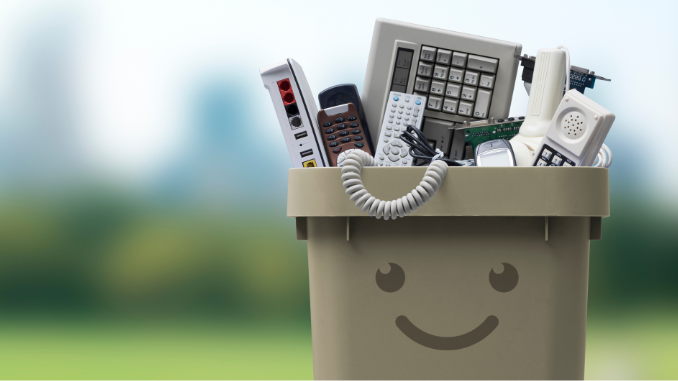As technology advances, a concerning issue emerges—growing electronic waste, a quiet environmental threat. The rising discard of gadgets filled with harmful substances poses risks to nature and human well-being. This article examines the reality of increasing e-waste, highlighting its significant impacts, and provides Ways To Reduce E-Waste.
So, let's discover practical ways to reduce e-waste and address this issue, navigating the complex world of electronic waste. Together, let's work towards a sustainable future with the ways to reduce e-waste, mindful of its consequences for our planet.
What Is E-waste?
Electronic waste, or e-waste, refers to dumped electrical or electronic devices. As technology advances, the rapid turnover of gadgets contributes to a growing global e-waste crisis. E-waste encompasses a wide range of electrical or electronic items.
These products carry hazardous materials such as lead, mercury, and brominated flame retardants, posing environmental and health risks if improperly handled. Improper disposal, often in landfills or through informal recycling, contaminates soil and water.
Moreover, developing countries often bear the brunt of e-waste as some discarded electronics are exported for recycling, further exacerbating environmental and health issues. Additionally, sustainable practices, responsible recycling, and raising awareness about the environmental impact of e-waste are crucial steps toward mitigating this global challenge.
Examples Of E-wastes

E-waste Around The World

E-waste, the fastest-growing global solid waste stream, presents substantial environmental and health challenges. In 2019, the global e-waste reached 53.6 million tonnes, but only 17.4% underwent formal collection and recycling. This stark disparity highlights the untapped potential for resource recovery.
Electronic devices contain valuable and limited resources such as precious metals, emphasizing the key role of proper recycling in reducing the need for new raw materials and mitigating environmental harm. Improper hazardous waste handling poses serious risks, releasing toxic chemicals and directly harm skin and threaten human health.
Furthermore, in low and middle-income countries, inadequate e-waste management exacerbates risks due to a lack of regulations, recycling infrastructure, and training. Vulnerable populations, especially children, bear the brunt of these environmental and health hazards.
Also, even though there are rules worldwide to stop electronic waste (e-waste) from being moved between countries, illegal transfers still happen, necessitating stringent enforcement and global cooperation to convert regulations into effective action.
The exponential growth of e-waste demands urgent attention. Effective e-waste management is a collective responsibility to safeguard our planet and the well-being of current and future generations. For a deeper understanding, explore the referenced sources for comprehensive insights about Ways To Reduce E-Waste.
Impacts Of Increasing E-waste
1. Environmental Pollution
Electronic waste has hazardous materials such as lead, mercury, and also cadmium. Improper disposal leads to soil and water pollution, affecting ecosystems and biodiversity.
2. Health Risks
Exposure to toxic substances in e-waste, either through informal recycling or disposal, poses significant health risks to communities. Such exposure is associated with respiratory issues, skin problems that hinders you to have a healthy and clear skin , and other ailments.
3. Resource Depletion
The rapid generation of e-waste contributes to the depletion of valuable resources like metals and minerals. Recycling also helps mitigate this impact by reclaiming materials from discarded electronics.
4. Electronic Toxin Accumulation
Toxins from e-waste can accumulate in the food chain, impacting terrestrial and aquatic organisms. This bioaccumulation also poses risks to human health through the consumption of contaminated food.
5. Energy Consumption
The disposal and production of electronic devices contribute to significant energy consumption. Extracting and processing raw materials for manufacturing electronics and recycling require substantial energy inputs, contributing to overall environmental impact.
The Need For Proper E-waste Disposal
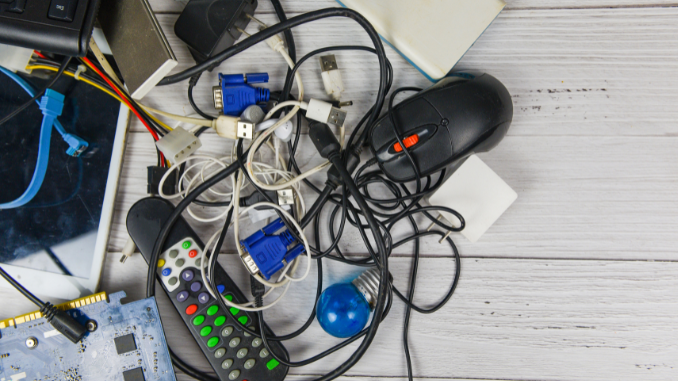
In our tech-driven era, proper e-waste disposal is crucial. Electronic devices, laden with hazardous materials like lead and mercury, pose environmental and health risks if disposed of incorrectly.
Moreover, the exponential increase in global discarded electronics emphasizes the urgency of responsible e-waste management. Recycling methods are key, salvaging valuable materials while minimizing environmental impact.
E-waste disposal is one of the Ways To Reduce E-Waste, and is intertwined with social responsibility; developing nations often process waste from wealthier counterparts, resulting in environmental degradation and health hazards. Prioritizing responsible disposal practices is essential for global environmental sustainability.
Legislative measures, public awareness campaigns, and accessible recycling facilities are vital in encouraging individuals and industries to adopt responsible e-waste management, ensuring a cleaner, safer future for our planet and its inhabitants.
Self-administered Ways To Reduce E-waste

A. Extended Device Lifespan
Use electronic devices for as long as possible before upgrading. Regular maintenance and immediate repairs can significantly extend their lifespan. This approach saves money and helps recover valuable materials from devices, reducing the overall environmental impact associated with manufacturing new electronics. Additionally, by keeping devices in use, you minimize the generation of electronic waste.
B. Responsible Disposal
When it's time to retire electronic devices, ensure proper disposal. Utilize local e-waste recycling programs or drop-off points to prevent hazardous materials, like toxic materials found in electronic equipment, from entering landfills. Recycling e-waste allows for the recovery of valuable materials and reduces the environmental burden of waste materials.
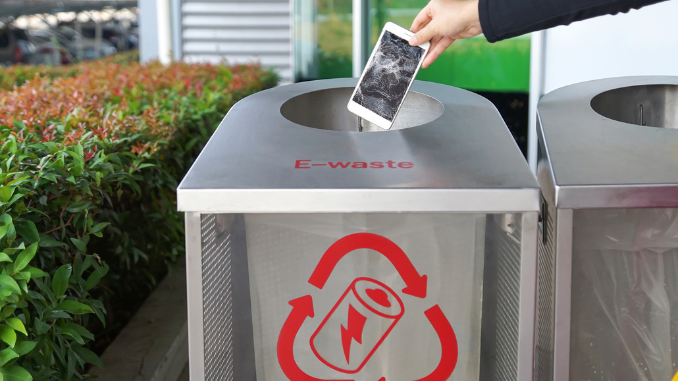
C. Donate Or Sell
Consider donating or selling unwanted electronics as one of the Ways To Reduce E-Waste. This not only extends the life of the devices but also reduces the demand for new manufacturing. By passing on your electronics, you contribute to waste reduction and the potential recovery of valuable materials from cell phones and other electronic equipment.

D. Buy Refurbished Or Secondhand
Opt for refurbished or secondhand electronics. This choice saves money and reduces the need for new production and its linked to environmental impact.
E. Eco-friendly Product Choices
Prioritize electronic products from companies committed to sustainability. Go green or look for eco-friendly certifications and brands with take-back programs. Choosing products from environmentally responsible manufacturers supports the recycling of e-waste.

F. Digital Minimalism
Adopt a digital minimalist approach by decluttering and organizing digital files. Avoid unnecessary downloads and subscriptions, reducing the need for storage and frequent device upgrades. This practice minimizes electronic waste and decreases the potential for toxic materials to enter the environment.
G. DIY Repairs
Learn basic repair skills or seek professional repair services to fix minor issues with electronics. Repairing instead of replacing contributes to waste reduction. It can aid in the recovery of valuable materials from cell phones and other electronic equipment.
How To Properly Dispose E-wastes
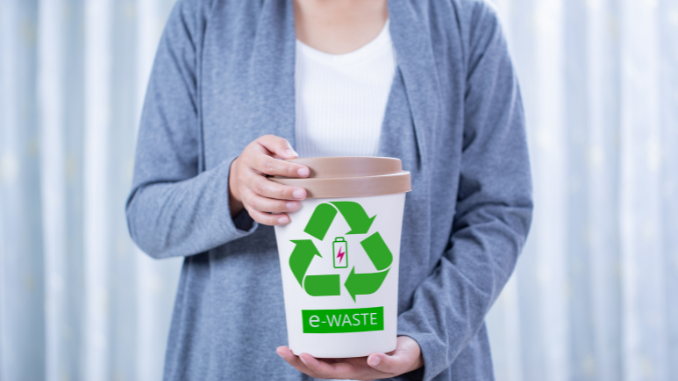
1. Research Local Regulations
Understand the e-waste disposal regulations in your area. Different regions may have specific guidelines and facilities for electronic waste. Adhering to local regulations ensures that you dispose of electronic devices in an environmentally responsible and lawful manner.
2. Locate E-Waste Recycling Centers
Identify authorized e-waste recycling centers or collection points in your community where you can recycle e-waste responsibly. Many municipalities have designated locations for dropping off electronic devices. These recycling centers specialize in handling electronic waste to extract valuable materials and minimize environmental impact. By utilizing these designated facilities, you actively contribute to the effort to recycle e-waste and reduce its environmental footprint.
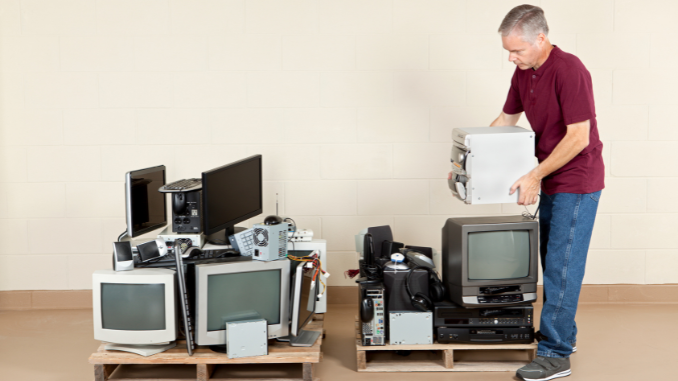
3. Check With The Manufacturer
Some electronic manufacturers have take-back programs for their products. Check if the company of the electronic device you're disposing of offers such services. Manufacturer programs often ensure proper recycling and may contribute to responsible e-waste management.
4. Remove Personal Data
Before disposing of devices like smartphones or computers, ensure you've wiped all personal data. Perform a factory reset or use data-erasing tools to protect your privacy. This step is critical for preventing unauthorized access to your sensitive information.
5. Participate In E-Waste Collection Events
Attend or participate in e-waste collection events organized by local authorities or environmental organizations. These events often provide convenient drop-off points and raise awareness about responsible e-waste disposal within the community.
6. Utilize Mail-In Recycling Programs
Some companies and organizations offer mail-in programs for specific electronic devices. You can ship the device to them for proper recycling. Mail-in programs provide a convenient option, especially for smaller devices, and ensure they are recycled responsibly.
7. Explore Manufacturer Trade-In Programs
Check if the manufacturer of your electronic device has a trade-in or recycling program. Some companies offer incentives or discounts for returning old devices when purchasing new ones. Participating in such programs encourages responsible disposal and may provide benefits to consumers.
8. Reuse Or Repurpose
Explore opportunities to reuse or repurpose electronic components. Old devices might be suitable for DIY projects or educational purposes. Repurposing electronics contributes to waste reduction and promotes creativity and innovation.

9. Seek Professional Disposal Services
For larger electronic items like refrigerators or televisions, consult professional disposal services. They can guarantee that the parts are properly handled and recycled. Professional services are essential for managing bulkier items and meeting environmental standards for disposal.
Take Away
In the tech world, it's crucial to properly care for our electronic devices and dispose of them responsibly. As users of these advanced gadgets, it's essential to ensure their longevity by using them mindfully and addressing issues promptly.
However, our responsibility goes beyond just using devices wisely – we must also dispose of them in an environmentally friendly manner, a concern that holds significance globally.
Furthermore, collaborating to recycle, refurbish old devices, and adopt eco-friendly practices is of utmost importance. Electronic waste contains harmful elements that can negatively impact nature and distant communities.
It is imperative for all nations, irrespective of their economic status, to unite and commit to reducing electronic waste. This joint effort can pave the way for a better future where we coexist harmoniously with the technology shaping our era.
Considering the entire lifespan of electronic devices is crucial. The collaboration between developed and developing countries is indispensable in organizing a unified effort to alleviate the electronic waste problem.
So, let's come together as a global community, working towards a future where responsible electronic waste management is a shared commitment, contributing positively to the well-being of our planet and all its inhabitants.
Poor posture, such as slouching, not only looks bad but can also have an incredibly detrimental impact on your overall health. Our 5 Daily Habits That Are Damaging Your Posture takes a deeper look at the daily tasks and routines that are playing havoc with your back, neck, and shoulder health. Don’t overlook this key element to better health. Improve your posture today!

